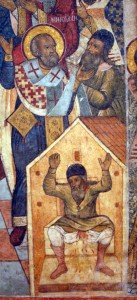guest post by Ellen Muehlberger
read Ellen’s article in the journal here
My article on ‘Imagination, Space, and Filth in Late Ancient Historiography’, in the May 2015 issue of P&P, traces the development over time of the infamous story about the death the fourth-century Christian intellectual Arius and considers its political impact. As a piece of writing, the article did not start and end at my desk. Instead, it too developed over a period of time, prodded along by the opportunities I had to present my work and the conversations I had with audiences who heard me. In 2009, when I was starting a new job and thinking about how to revise my dissertation into a book, I did what many writers do: I workcrastinated, at times, by daydreaming about a future project. I wanted to investigate in more detail a change that other historians of ancient Christianity had noted: that after the fourth century, there was a dramatic increase in graphic, gruesome depictions of death in Christian writing. Many of the nasty deaths narrated in late ancient Christian literature came with a lesson. Often the enemies of Christians, or those who were declared heretics, were the ones who died in filthy ways. Arius’s death was particularly embarrassing: he died, many sources report, from uncontrollable diarrhea.
That’s about as much as I had registered when the Eisenberg Institute for Historical Studies at the University of Michigan, where I work, asked me to give a lecture in their series, “Taking Place: History and Spatial Imaginations.” To give a talk that addressed that theme, I was forced to think more deeply about the variations in the ancient historiography about Arius’s death. So, I started to pay more attention to the part of the story that shifted most over time, namely, its setting. Early versions of the tale had Arius dying in private, but later versions located his death in the middle of a central public space in Constantinople. In the talk I gave, I had the chance to wonder about what a story (which had no basis in fact, as far as could be determined) could accomplish, culturally, when its tellers situated it in an already existing and well-planned built landscape.
From that talk came another opportunity. The Social History of Formative Christianity and Judaism section at the Society of Biblical Literature was sponsoring a panel on “Landscapes and Cityscapes” the following fall, and my colleague at Michigan Rachel Neis suggested me as a participant. The respondent for the panel, Blake Leyerle from Notre Dame, pushed me to look in a theoretical direction, drawing my attention to Michel de Certeau’s “The Institution of Rot,” which explains that stories about filth, seemingly occasional and organic, often implicitly point to larger structures. I followed that line, making use of Blake’s work on filth, and I started to think of the increasingly specific situations of Arius’ death in ancient historiography as increasingly refined statements in a fifth-century debate about religious ritual, visual representation, and public space.
Admittedly, that is a lofty set of topics to draw from a story about one historical actor’s fatal gastrointestinal problems. It is the type of story that gets attention, but not a lot of critical or historical attention. That is in part because it is a set piece, told in isolation from other stories, and it focuses on a marginal figure. When scholars of early Christianity have considered it, it has been either to evaluate its historicity—did Arius really die this way?—or to read its symbolism. My confidence about being able to draw a different kind of historical observation from the story was high, though, because I had just published an article that treated another marginal figure from early Christian literature: Macrina, the pious sister of Gregory of Nyssa. Her story, too, had inspired either observations on its reality—taking it as a portrait of a real early Christian woman—or efforts to uncover its symbolic functions. In that article, I tried to articulate a third option: that a story can itself be a political argument—not just a reflection of a certain context or a distillation of other more explicitly worded statements, but its own type of contribution to an ongoing controversy.
To make such an argument is not without risk. I could certainly be wrong. The stories of marginal actors like Arius have not inspired long-running scholarly conversations, so there was not much in the way of prior secondary scholarship about Arius, his legend, and its potential political consequences. If I wanted to see what the story of Arius had accomplished, I would have to do so by crossing into fields of expertise that were far beyond my own. In the case of this piece, that meant fourth- and fifth-century Christian theology, imperial programs of ideology and representation, and the history of late ancient Constantinople itself, all of which are subjects with robust communities of scholars working directly and only on them.
I am a novice in all these things, but to follow the thread of the Arius legend, I had to write about them. Thankfully, many experts lent me their time. Between the comments from readers I approached on my own and the suggestions of the anonymous reviewers and the editor for Past & Present, I gained a great deal of insight into these other areas. Their collective help was the last in a long line of interventions that created the piece we hope you’ll now read. I know it is commonplace for authors to say it, but here it is also true: whatever is wrong in this article belongs to me, but whatever is insightful or useful belongs to the gradual process of articulation, critique, and revision that can only take place over time.

